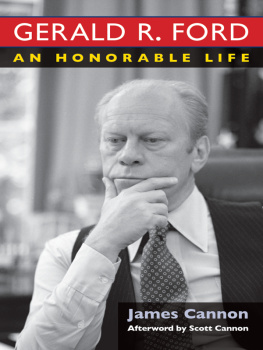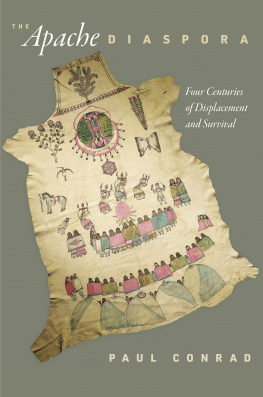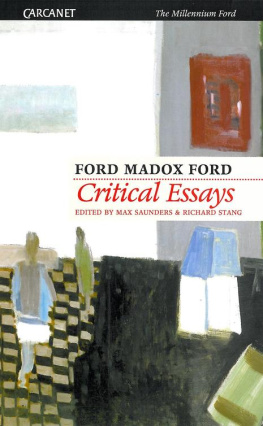Armstrong Paul B. - The challenge of bewilderment: understanding and representation in James, Conrad, and Ford
Here you can read online Armstrong Paul B. - The challenge of bewilderment: understanding and representation in James, Conrad, and Ford full text of the book (entire story) in english for free. Download pdf and epub, get meaning, cover and reviews about this ebook. City: Ithaca, year: 1987;2018, publisher: Cornell University Press, genre: Art. Description of the work, (preface) as well as reviews are available. Best literature library LitArk.com created for fans of good reading and offers a wide selection of genres:
Romance novel
Science fiction
Adventure
Detective
Science
History
Home and family
Prose
Art
Politics
Computer
Non-fiction
Religion
Business
Children
Humor
Choose a favorite category and find really read worthwhile books. Enjoy immersion in the world of imagination, feel the emotions of the characters or learn something new for yourself, make an fascinating discovery.
- Book:The challenge of bewilderment: understanding and representation in James, Conrad, and Ford
- Author:
- Publisher:Cornell University Press
- Genre:
- Year:1987;2018
- City:Ithaca
- Rating:3 / 5
- Favourites:Add to favourites
- Your mark:
- 60
- 1
- 2
- 3
- 4
- 5
The challenge of bewilderment: understanding and representation in James, Conrad, and Ford: summary, description and annotation
We offer to read an annotation, description, summary or preface (depends on what the author of the book "The challenge of bewilderment: understanding and representation in James, Conrad, and Ford" wrote himself). If you haven't found the necessary information about the book — write in the comments, we will try to find it.
Armstrong Paul B.: author's other books
Who wrote The challenge of bewilderment: understanding and representation in James, Conrad, and Ford? Find out the surname, the name of the author of the book and a list of all author's works by series.
The challenge of bewilderment: understanding and representation in James, Conrad, and Ford — read online for free the complete book (whole text) full work
Below is the text of the book, divided by pages. System saving the place of the last page read, allows you to conveniently read the book "The challenge of bewilderment: understanding and representation in James, Conrad, and Ford" online for free, without having to search again every time where you left off. Put a bookmark, and you can go to the page where you finished reading at any time.
Font size:
Interval:
Bookmark:

For my parents
This book has three central, related concerns. It tries first to describe precisely and in detail the epistemologies implicit in the adventures of interpretation which the characters undergo in the novels of Henry James, Joseph Conrad, and Ford Madox Ford. For these pivotal writers in the history of the novel, the act of understanding is a drama in its own right, and we should consequently distinguish with some care the similarities and differences that mark their attitudes toward knowing. Second, however, their investigations of understanding also lead them to experiment with the workings of representation. Their narrative experiments expose the ways in which the conventions of realism take advantage of our everyday epistemological habits in order to give us an illusion of immersion in a lifelike world. Third, and consequently, their strategies of representation are a challenge to the reader to reflect about realism and interpretation. James, Conrad, and Ford manipulate the readers response to their works so as to educate about processes of construing and creating meaning, which usually go unnoticed in our unreflective engagement with objects, people, and texts. The argument joining these three concerns is that James, Conrad, and Ford help inaugurate the self-consciousness of the modem novel about signs and interpretation by shifting the focus of the genre from constructing lifelike worlds to exploring the dynamics of world construction.
Analyses of the reading experience are sometimes controversial because of skepticism about the stability and determinacy of response. pretend that the responses I describe in the following pages are prestructured by the text or shared completely by all informed readers. My arguments about what the reader experiences are not unbiased accounts of independent givens but necessarily reflect my presuppositions and interests. Such bias is not unique to studies of reading, however; it can be found in all kinds of interpretation, no matter what they assume or seek to show. My analyses of the readers responselike all interpretationsare both descriptive and prescriptive in their claim to validity. I try to identify patterns other readers will recognize as aspects of their experience with the work and I often cite as support the typical, recurrent reactions the work has evoked. But I also hope to persuade my readers that, if they have not experienced what I describe, they shouldthat their experience of the work will be deepened and refined if they adopt my presuppositions, interests, and interpretive hypotheses. Like all methods of criticism, an investigation of the readers experience attempts a dual taskto clarify what others may also have seen but not fully understood and to offer new ways of seeing which are available only if we take up new assumptions and aims.
My goal is to explicate the unique but related epistemologies of James, Conrad, and Ford and not merely to use their works as an occasion to air my own views about interpretation. My argument that they occupy a special, transitional position in the history of representation acknowledges that their works belong to a past that stands at a distance from contemporary concerns. I also show that they differ substantively and in emphasis about how we understand, how much we can know with what certainty, and what the ethical, political, and metaphysical implications of interpretation are. My own theory of understanding is the subject for another book.
The relation between past and present is not quite this simple, however. A literary work is not a timeless monument that offers the same unchanging face to every reader in all periods. The meaning of a work will vary according to the questions we ask it, and these cannot help but reflect the historical position of the interpreter. Indeed, the power of works to offer Although James, Conrad, and Ford address the epistemology of world construction from a particular standpoint in the novels history, the questions I ask them about the role of belief in understanding, the problem of validity, and the challenges of pluralism are necessarily related to contemporary debates about interpretation. And this is a benefit rather than a disadvantage. Contemporary theoretical thinking about meaning and understanding can offer conceptual instruments to clarify how James, Conrad, and Ford portray the act of interpretation. In turn, their explorations of the powers and limits of our ability to know have much to say to contemporary concerns. We can learn as much about signs, representation, and understanding by contemplating The Ambassadors, Lord Jim, or The Good Soldier as we can from studying Heidegger, Gadamer, or Ricoeurand possibly more. What I know about the theory of interpretation has influenced my reading of James, Conrad, and Ford, but they have contributed much to what I know about interpretation.
A substantial part of the Introduction appeared in The Centennial Review 27 (Fall 1983), and a portion of Chapter 2 was published in Amerikastudien 31 (Summer 1986). Selections from Chapter 4 were published in Twentieth Century Literature 31 (Spring 1985). An early version of Chapter 5 appeared in Criticism 22 (Summer 1980). I am grateful to the editors for permission to use these materials.
I am happy to acknowledge the debts I accumulated while writing this book. Many friends and colleagues read parts or all of the manuscript and offered valuable advice and criticisms: Richard Cassell, Darryl Gless, David Leon Higdon, David Langston, Austin Quigley, and John Carlos Rowe. Teacher, mentor, and friend Thomas C. Moser has been an unfailing source of generous encouragement. Wolfgang Iser made a number of important suggestions and asked some searching questions at a formative stage of the project. Evelyne Keitel read several versions of the manuscript with great care and intelligence, and our many conversations have sharpened my understanding of crucial theoretical points. A summer stipend from the National Endowment for the Humanities helped launch this project, and a fellowship from the Alexander von Humbolt Foundation facilitated the completion of a first draft. I am also grateful to Tina and Tim in ways I cannot easily enumerate.
Paul B. Armstrong
Eugene, Oregon
For example, see the dispute between Stanley Fish, Why No Ones Afraid of Wolfgang Iser, Diacritics 11:1 (1981), 213; and Wolfgang Iser, Talk like Whales, Diacritics 11:3 (1981), 8287.
Some of my own preliminary work on this project has appeared: The Conflict of Interpretations and the Limits of Pluralism, PMLA 98 (1983), 34152; Understanding and Truth in the Two Cultures, Hartford Studies in Literature 16:23 (1984), 7089; The Multiple Existence of a Literary Work, Journal of Aesthetics and Art Criticism 44 (1986), 32129.
See Hans Robert Jauss, Literary History as a Challenge to Literary Theory, in Toward an Aesthetic of Reception, trans. Timothy Bahti (Minneapolis: University of Minnesota Press, 1982), especially pp. 2036; and Hans-Georg Gadamer, Truth and Method, trans. Garrett Barden and John Cumming (New York: Seabury, 1975), pp. 24574, 33341.
The art of the novel, according to Henry james, is the art of representation. In the history of the novel, however, the tradition of realistic representation reaches a turning point with James and his fellow literary impressionists Joseph Conrad and Ford Madox Ford. These three writers challenge the conventions of realism. They examine self-consciously the processes of meaning-creation and interpretation which most traditional fiction quietly exploits to achieve verisimilitude. Their innovative, self-reflexive fictions take the first steps down the road that the modem novel travels as it moves away from fidelity to the everyday, social world and toward increasing experimentation with narrative structure and a growing fascination with the psychological and the fantastic. As they play with the workings of representation, the literary impressionists explore how we construct reality by interpreting it. Their narrative experiments challenge our sense of reality and lead us on a journey of discovery into the mysteries of how we create and construe meaning. James, Conrad, and Ford thereby inaugurate the self-consciousness of modem fiction about signs and interpretationthe widespread awareness in the literature of our century that we live in a world of signs that, when we interpret them, lead only to other signs and so on ad infinitum.
Next pageFont size:
Interval:
Bookmark:
Similar books «The challenge of bewilderment: understanding and representation in James, Conrad, and Ford»
Look at similar books to The challenge of bewilderment: understanding and representation in James, Conrad, and Ford. We have selected literature similar in name and meaning in the hope of providing readers with more options to find new, interesting, not yet read works.
Discussion, reviews of the book The challenge of bewilderment: understanding and representation in James, Conrad, and Ford and just readers' own opinions. Leave your comments, write what you think about the work, its meaning or the main characters. Specify what exactly you liked and what you didn't like, and why you think so.











